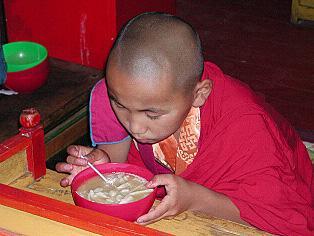 In the crimson-painted interior of the Shand Khiid monastery in
In the crimson-painted interior of the Shand Khiid monastery in
central Mongolia, boys as young as 6 face one another cross-legged on
benches and chant Tibetan Buddhist prayers that they barely understand, says a
report in the Los Angeles Times.
Some fidget and get up every now and then to ladle bowls of fermented horse
milk from a large metal vat. Their teachers occasionally call out directions.
The boys are at a three-month religious camp at the monastery. The oldest monk
in residence is 97. A visiting sage from Tibet relaxes in a back room, watching
sports on television.
According to a monk who showed a group of visitors around one
recent day, the monastery guarded Genghis Khan”s black flag of conquest until
it was moved to Mongolia”s National Museum of History in 1994, four years after
the collapse of the socialist system. Today, Buddhism in Mongolia continues to
emerge from a decades-long hiatus.
“During the Communist period, you had a
devastation of Buddhism in terms of the material culture and the loss of
knowledge,” said Vesna Wallace, a professor of religious studies in
California. “Now more people are coming to temples and visiting monasteries.
There is also a new interest in meditation among the general public.” Wallace,
an expert on Mongolian Buddhism, has spent the last 10 summers there and has
seen Buddhist youth groups grow from three or four people to major gatherings.
She says Mongolians have reclaimed Buddhism as an integral part of their
national identity.
Couples who grew up with no religion are now choosing to be
married in temples and by monks. The Gandan monastery in the capital is the
largest in the country and busier than it”s been in decades.
 Mourners across Mongolia are again consulting
Mourners across Mongolia are again consulting
monks before deciding whether a loved one should be buried, cremated or left
outside to the elements for what”s known as a “sky burial.” And
prayer piles, enormous cairns known as ovoos, have sprung up around the
countryside. Truck drivers leave punctured tires to pray for safe travels and
shepherds leave livestock skulls in hopes of a healthy herd. Blue scarves
flutter in the wind, symbols of the blue sky that Mongols worshiped in the pre-Buddhist
period.
Mongolian Buddhism is predominantly the Yellow Hat
sect of Buddhism practiced in Tibet and China. But Wallace says it has evolved
into its own version, having incorporated the pre-Buddhist religion of tengerism
as well as shamanistic influences.
“Tibetans prefer white scarves, Mongolians
prefer blue,” she said. “Even certain deities that are preferred by
Mongolian Buddhism are the blue ones that represent eternity, spaciousness and
the comprehensiveness of the sky.”
Mongolia, with half of its 2.8 million people
living in Ulaanbaatar, is one of the most sparsely populated countries in the
world, with vast tracts of open grassland. In 1578, Genghis Khan”s descendent
Altan Khan made Buddhism the official religion, installing the Tibetan Sonam
Gyatso as Dalai Lama and conscripting males to
monasteries instead of into the army.
The country”s oldest monastery, Erdene Zuu, was
built in 1585 in the ancient capital of Karakorum, the ruins of which can still
be seen near the town of Kharkhorin. At its height, Erdene Zuu was home to 67
temples and 1,500 monks. Today, 28 monks live on the site and 18 structures
still stand. The monks use one temple for study and chanting, while the other
buildings are open to the public.
In 1937, the Soviet-allied Mongolian Communist
Party banned Buddhism and persecuted its 100,000-strong priestly class. The
government executed nearly 20,000 lamas, or Buddhist teachers, and at least
10,000 educated monks. Another 10,000 were sent to Siberian labor camps. Most
of the country”s 2,000 monasteries were destroyed. During decades of official
atheism, some Buddhists continued to practice their faith privately in their
homes. The devout would pretend to play cards but instead discuss Buddhism and
pray. Children would act as guards to make sure no officials were coming.
“My mother is a very strong Buddhist. Even in
the Communist time, when she had a problem and a child was sick, she would
visit a monk”s home to ask advice. It was so secret,” said Enkhtuya, 40,
an elementary school teacher in Ulaanbaatar. Like many Mongolians, she uses
only one name.
Munkhbaatar Batchuluun was 11 when democracy
arrived in 1990. Elders in his village southwest of Ulaanbaatar restored their
small yurt-shaped monastery and revived chanting ceremonies. “It was very
new. People were brainwashed against religion. I was very curious and
visited,” recalled Munkhbaatar, now secretary of foreign relations at the
Gandan monastery. “I was so impressed I went home and asked my parents if
I could join. At first they weren”t happy; people would laugh at monks and
tease them as state enemies. But eventually my father agreed.”
Much has changed. Most Mongolians now identify
themselves as Buddhist. And the Dalai Lama has made seven visits to Mongolia,
five of them since 1990. Still, it has been a struggle to re-educate the
public, especially since few sacred texts are translated from Tibetan to
Mongolian, and there still aren”t enough teachers.
In recent years, a new competitor has arisen:
Christianity. Many Christian missionaries arrived in Mongolia after the fall of
communism, just as they did in Eastern Europe. The largest groups now
converting Mongolians are American Mormons and South Korean fundamentalists.
Still, as grandparents show their grandchildren
around monasteries explaining the prayer wheels, altars and parchment books, it
is clear that Buddhism runs deep in Mongolia.
“The Communists cleaned it from our body and from our speech,
but they couldn”t remove it from our souls,” Munkhbaatar said. “The
people may not have a lot of Buddhist education and understanding, but they
have Buddhist faith.”
 3,381.24
3,381.24







